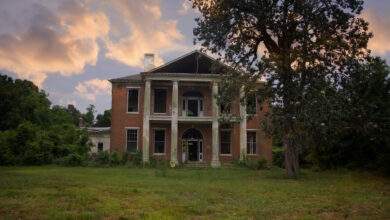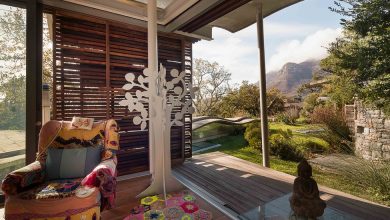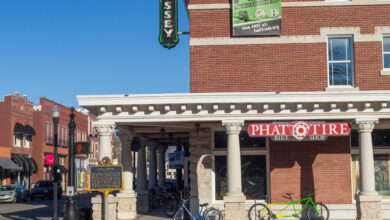Celebrating a Phoenix of a Home in Los Angeles

This article is part of our latest Design special report, about creative people finding fresh ways to interpret ideas from the past.
When Joyce Poulson was awakened by her fire alarm in the early morning of Nov. 12, 2018, she didn’t see any flames or smell smoke. She went upstairs in her butterfly-roof house in Los Angeles’s Silver Lake neighborhood to try to turn off the alarm and, failing at that, called the alarm company.
“While I was on the phone a tornado of fire came up the stairs,” she said. “I had to run by it to get to the door. I don’t know how my nightgown did not catch on fire.”
By sunrise it was clear that her 1,640-square-foot, wood-frame home had burned to the studs because of an errant ember that had been trapped, invisible, between the fireplace and the wall. Her insurance company would soon call the historically important building a total loss.
Today, the 69-year-old house, originally designed by Ain, Johnson and Day for Marjorie M. Greene, an artist and early childhood educator, looks as fresh as it did in 1952. It has been painstakingly restored by Escher GuneWardena Architecture, thanks to archival research, preservation of the remaining structure and forensic reconstruction of the plans as even the original blueprints, stored in a closet in the lower floor, were burned to char.
A week or two after the fire, Ms. Poulson, 78, contacted the firm’s partners, Frank Escher and Ravi GuneWardena, at the suggestion of a neighbor who knew Mr. GuneWardena from having studied abroad, and asked them to rebuild it.
She could not have selected more eager and experienced architects. The 25-year-old firm had also worked on the conservation of the Eames House and the restoration and the remodeling of John Lautner’s Chemosphere house. While less well known than Lautner or Charles and Ray Eames, Gregory Ain (1908-1988), a principal designer of the house, was an integral part of Los Angeles’s Modernist movement and American architects’ search for low-cost, innovative and flexible housing for the masses.
His Mar Vista Tract, also designed with Joseph Johnson and Alfred Day and completed in 1948, was designated Los Angeles’s first Modernist historic district in 2003. It showed how even identical houses, their plans mirrored or rotated and oriented toward lush common green space, could create a neighborhood of variety and charm.
Ain’s firm followed that up with Community Homes, a racially integrated cooperative designed for 280 families, including those of the landscape architect Garrett Eckbo (a friend and frequent collaborator) and the singer and actress Lena Horne, but was unable to get government financing. Ain and Eckbo, both Socialists, decided to let the project die rather than undertake it as a whites-only suburb. The California Senate Fact-Finding Committee on Un-American Activities would later declare Ain “among the committee’s more notorious critics.”
Ms. Poulson, a retired computer software salesperson, embarked on a love affair with modern architecture long before 1988, when she bought the Greene house, of which she was only the third owner. In the early 1960s she rented one of the apartments behind the architect Richard Neutra’s studio (Ain worked for Neutra in the 1930s.) In the 1980s she lived in the guesthouse of the Neutra VDL House, where she attended classical music concerts featuring the architect’s widow, the musician Dione Neutra.
“Every time she started to describe anything she was very emotional,” said Mr. GuneWardena, about his initial conversations with Ms. Poulson. “She said it was a Gregory Ain house, it was in a magazine she had, but that was in the house. Several times she said, ‘I’ll show you the photos,’ then she remembered the photos had burned.” They arranged to meet at the skeleton of the house. The designers “immediately realized this was an important house and said, ‘Don’t tear down anything,’” Mr. GuneWardena recalled.
Among their first tasks was proving that the Greene house was, in fact, by Ain, a necessary step if they wanted to add the house to the inventory of HistoricPlacesLA, a preservation database, and apply the city’s preservation codes to the restoration. The building permit named only Johnson and Day, Ain’s onetime partners, as did the plans in the Eckbo archive at the University of California, Berkeley.
But the Ain archive at the University of California, Santa Barbara, had a folder of unidentified projects and there, lo and behold, they found two presentation drawings marked “Marjorie Greene, 1952.” Rereading a chapter on Ain in Esther McCoy’s “Second Generation,” a 1984 book about California architects, Mr. Escher and Mr. GuneWardena noticed a reference to a singular, unpictured Ain house with a butterfly roof just like the Greene house. Sasha Plotnikova, the project manager for the research phase on the house, also noticed that the plan was very similar to one of Ain’s most famous works, the 1950 Exhibition House for the Museum of Modern Art, intended as a demonstration of a subdivision-ready house of high-quality modern design — a corrective to the traditional, boxy forms of nascent Levittowns.
(Until recently, the Ain house for MoMA had long been thought to be a lost design. Christiane Robbins and Katherine Lambert, a filmmaker and an architect, who have been researching Ain for more than a decade and sharing parts of their documentary-in-progress, had asked MoMA for documentation on the house and received only a slim file. In early 2021, however, George Smart, the North Carolina-based historian who founded and runs the preservationist nonprofit USModernist, discovered the house had survived, auctioned off and reassembled in Croton-on-Hudson, N.Y., where a family named Kelly has lived in it since 1979.)
The Los Angeles version is now on record as a sibling. “This house is super site-specific,” located on a hillside rather than in one of the flat suburban tracts Ain wanted to reform, said Anthony S. Denzer, a professor of architectural engineering at the University of Wyoming and author of “Gregory Ain: The Modern Home as Social Commentary” (2008). “It seems to me that probably Marjorie Greene came to Ain because she had seen the MoMA house and said, ‘I really like that,’ but then he adapted it to the site.” Greene herself had an architectural pedigree: she was the niece of the prolific Pasadena architects Greene & Greene.
“If it were simply a remodel job of a nonhistoric house, they would have to bring it up to new seismic codes and new energy codes,” said Mr. Denzer. This would have likely required the addition of solid shear walls within the two-story glass wall facing Silver Lake, radically altering the open look and feel of the house. (One new code that does apply: sprinklers.) “I can say with confidence he designed the house,” Mr. Denzer said, but he doesn’t know why Ain didn’t include it in his own archive. Ain’s preference for perfecting a detail, and then using it in project after project, came in handy, as the designers could look to his other buildings of the same era for window or cabinetry details.
Mr. Escher and Mr. GuneWardena estimated that, in the end, 50 percent of the house’s original materials were retained, including the framing of the butterfly roof, sections of the subfloor and floor structure, the brick fireplaces and almost all the concrete. Most of that is under cover, with new birch plywood cabinetry, new cork tile and new plaster over wood framing that is sometimes original, sometimes replaced, and sometimes sistered — new elements tied to the old with nails or screws for strength.
The reconstruction took 18 months and was completed in April. Ms. Poulson’s favorite spaces in the house remain the same: the nook in which she can read in her Eames lounge chair and look across the length of Silver Lake; and the highly efficient kitchen, in which she can reach sink, stovetop and pantry with a minimum number of steps.
“It’s beautiful to be in the living room and be able to look into that kitchen area — it is like one long extension of itself,” she said. “Even though there are homes on either side of me, I don’t hear or see a single thing except the lake and my garden.”
The marks of the fire are visible in only two places. You can see it outdoors, where the char on a built-in Eckbo-designed pentagonal table was scraped off and its newly irregular ends sealed. “Now it is similar to something George Nakashima would have designed,” with a free edge, “because of the burning,” said Mr. GuneWardena. Delia Hitz, a garden designer, updated Eckbo’s beds, their edges intact, with all native plants that should require less water.
And inside, damage is visible (barely) at the scene of the accident: “I suppose if you looked really carefully at the fireplaces you could tell,” said Ms. Poulson. “They had to clean them to get the brick back to brick, but there is smoke damage inside the fireplaces where it is black.” She said she would never light a flame there again.
Apart from those vestiges, the house looks and feels exactly as it did when she moved in, she said. “I don’t know how they did it.” She is grateful to be back after her time in exile living above the Americana at Brand complex: “For me it had a lot of bling, a lot of people, everything was too much there,” she said.
Ms. Poulson also cherishes how the reconstruction process taught her so much about the house, “about Gregory Ain and other architects too,” she said. “I love my house now more than before the fire — it means so much more to me now.”
Source link






